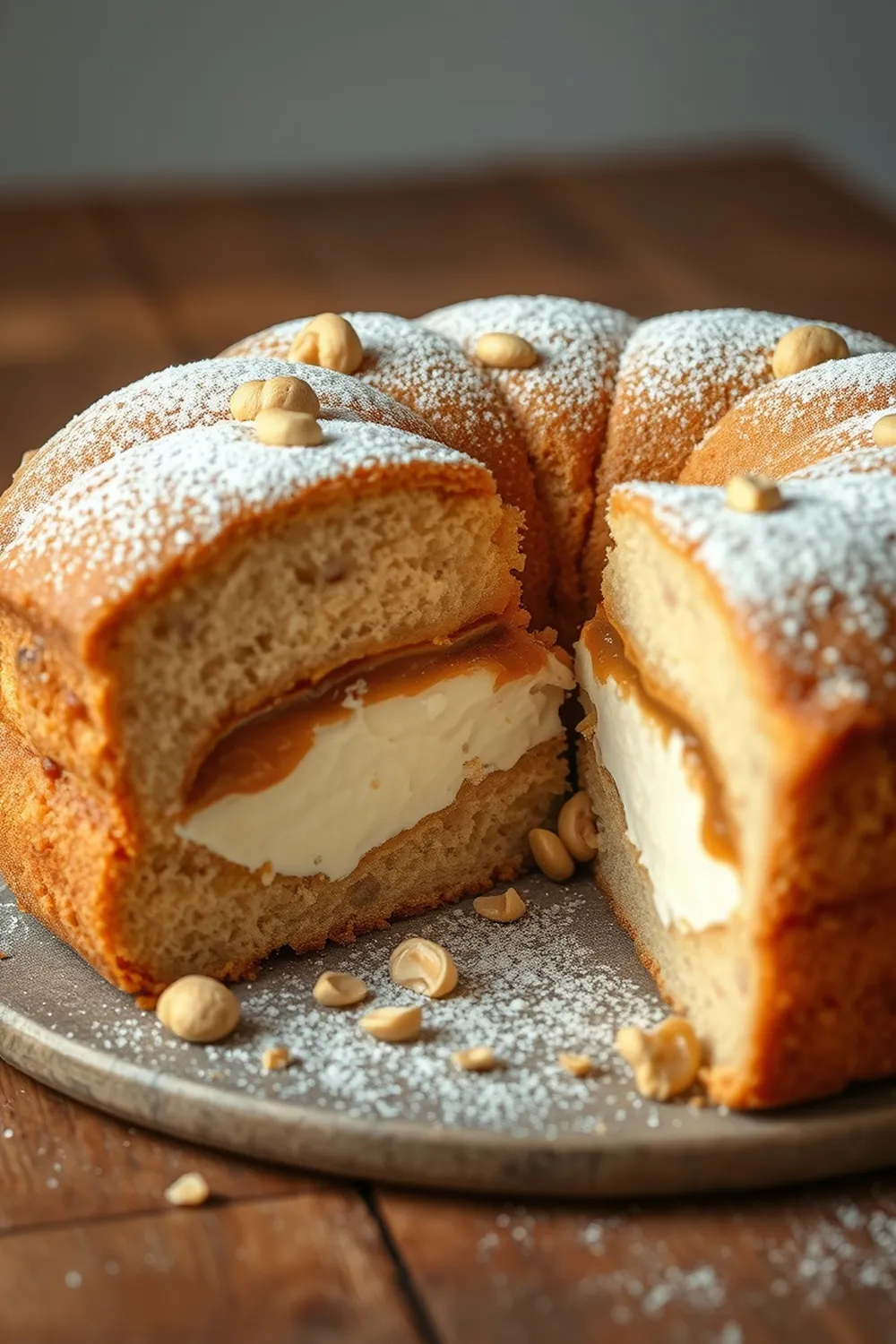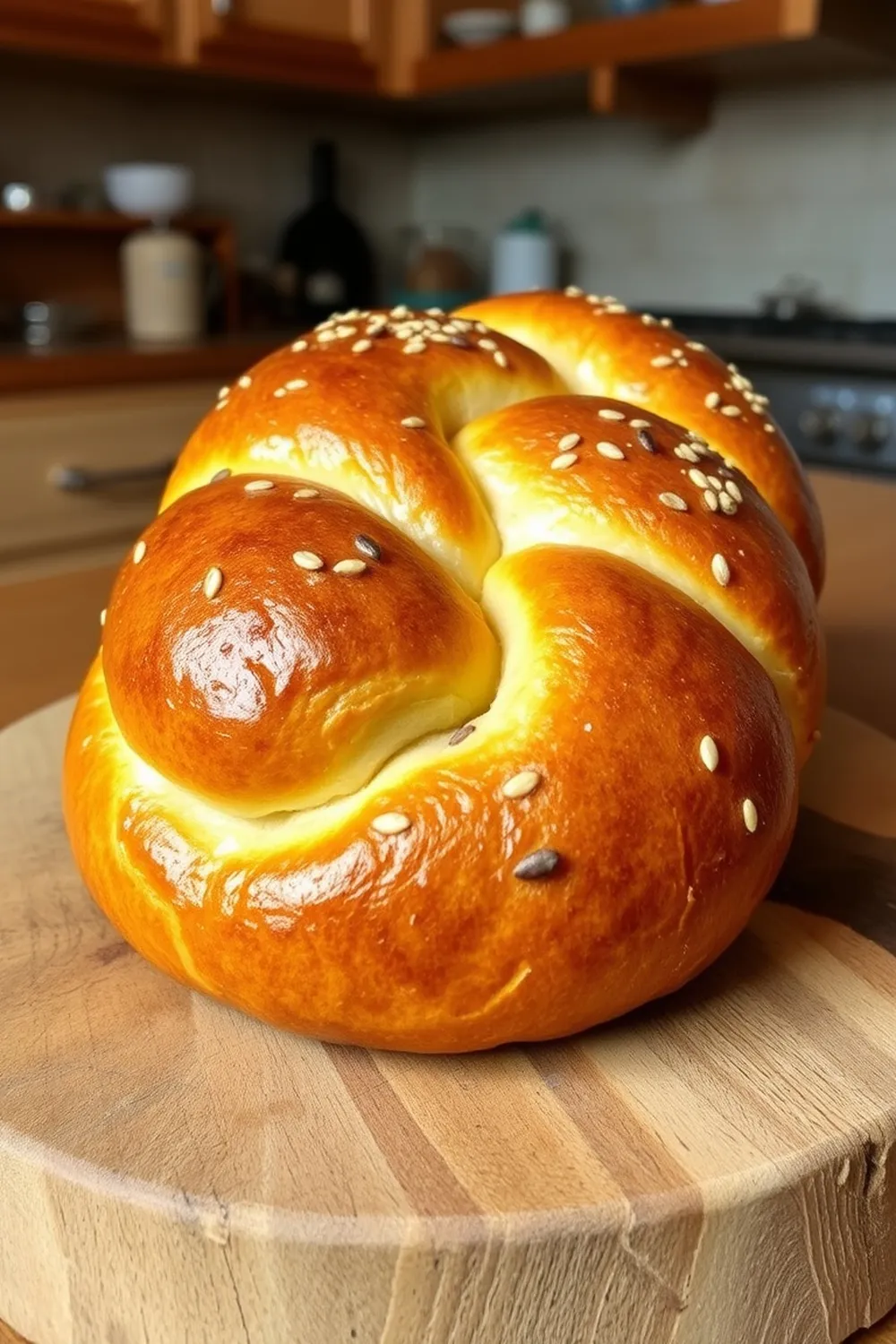- Proof active dry yeast in lukewarm water with sugar for 10-20 minutes, until foamy.
- Prepare light rye dough by mixing flours, salt, yeast mixture, molasses, shortening, and water. Knead for 7-10 minutes until the dough is pliable.
- Prepare dark rye dough similarly, adding cocoa powder to the dry ingredients. Knead until smooth.
- Let both doughs rise in oiled bowls for 1 hour to 1 hour 45 minutes, or until doubled in size.
- Divide each dough into 3 equal parts. Roll each part into an 18-inch tapered strand.
- Alternate light and dark strands. Braid using a 6-strand technique, tucking the ends neatly under the loaf.
- Transfer the braided loaf to a parchment-lined baking sheet. Let rise for 45-60 minutes.
- Preheat oven to 350°F. Brush loaf with egg wash and press caraway seeds into the surface.
- Bake for 45-50 minutes, or until the internal temperature reaches 200-210°F. Cool completely before slicing and serving.
- Calories:2800 kcal25%
- Energy:11715 kJ22%
- Protein:120 g28%
- Carbohydrates:550 mg40%
- Sugar:30 mg8%
- Salt:600 g25%
- Fat:15 g20%
Last Updated on 3 months by Neha Deshmukh
Dark & Light Rye Bread Recipe – Cocoa, Molasses & Caraway Seeds
Introduction
There’s just something magical about the smell of freshly baked bread, isn’t there? Especially when it’s a loaf as wonderfully complex as this Dark & Light Rye Bread. I first stumbled upon a version of this recipe while researching traditional Indian breads – the use of molasses and caraway seeds reminded me of flavors found in some of our regional baking! This isn’t your average loaf; it’s a beautiful braid, boasting a delightful contrast between the subtly sweet light rye and the rich, cocoa-infused dark rye. It’s a bit of a project, yes, but trust me, the reward is so worth it.
Why You’ll Love This Recipe
This rye bread isn’t just about taste; it’s about the experience. The braiding is therapeutic, the aroma fills your home with warmth, and the flavor… well, the flavor is simply unforgettable. It’s perfect for sandwiches, toast, or simply enjoying with a smear of butter. Plus, it’s a fantastic way to explore the world of rye baking!
Ingredients
Here’s what you’ll need to create this masterpiece:
- 1 cup bread flour (unbleached) – about 120g
- ?? cup white rye flour – about 125g (see ingredient notes below!)
- 1 teaspoon active dry yeast – about 3g
- ?? cup lukewarm water (for proofing yeast) – about 240ml
- ?? teaspoon sugar – about 5g
- ?? tablespoon molasses – about 15ml
- 1 tablespoon shortening – about 14g
- ?? cup water – about 240ml
- 1 teaspoon salt – about 6g
- 2 tablespoons cocoa powder – about 10g
- 1 egg
- 1 teaspoon water (for egg wash)
- ?? tablespoon caraway seeds – about 10g
Ingredient Notes
Let’s talk ingredients! Getting these right will make all the difference.
White Rye Flour: Understanding its Role
White rye flour is the star here, giving the bread its characteristic flavor and texture. It’s less glutenous than wheat flour, so it creates a slightly denser, more moist loaf. If you’re unsure about the quantity, start with ¾ cup (about 85g) and add more as needed to achieve a pliable dough.
Bread Flour: Choosing the Right Protein Content
Bread flour is essential for structure. The higher protein content helps develop gluten, giving the bread a good rise and chew. Unbleached is my preference, but bleached will work too.
Molasses: Varieties and Flavor Impact
Molasses adds a lovely depth of flavor and a subtle sweetness. I prefer dark molasses for a richer taste, but light molasses will also work. You can even experiment with blackstrap molasses for an even bolder flavor!
Cocoa Powder: Dutch-Processed vs. Natural
For the dark rye dough, cocoa powder adds a beautiful color and a hint of chocolatey goodness. Dutch-processed cocoa will give a darker color and milder flavor, while natural cocoa will be brighter and more acidic. Either works well – it’s down to personal preference.
Caraway Seeds: A Traditional Flavor Profile
Don’t skip the caraway seeds! They’re a classic pairing with rye bread, adding a warm, slightly anise-like flavor. Toasting them lightly in a dry pan before adding them to the loaf intensifies their aroma.
Step-By-Step Instructions
Alright, let’s get baking!
- Proof the yeast: In a small bowl, combine the lukewarm water, sugar, and yeast. Let it sit for 10-20 minutes, until it gets nice and foamy. This tells you your yeast is alive and kicking!
- Make the light rye dough: In a large bowl, combine the bread flour, white rye flour, salt, yeast mixture, molasses, shortening, and water. Knead for 7-10 minutes, until the dough is smooth and pliable. It will be a little sticky, that’s okay!
- Make the dark rye dough: Repeat the process, but add the cocoa powder to the dry ingredients. Knead until smooth.
- First rise: Place both doughs in lightly oiled bowls, turning to coat. Cover and let rise in a warm place for about 1 hour 45 minutes, or until doubled in size.
- Divide and shape: Gently punch down each dough. Divide each into 3 equal parts. Roll each part into an 18-inch tapered strand.
- Braid it up: Alternate a light strand and a dark strand, braiding using a 6-strand technique. Tuck the ends neatly under the braid.
- Second rise: Carefully transfer the braided loaf to a parchment-lined baking sheet. Cover and let rise for another 45 minutes.
- Bake: Preheat your oven to 350°F (175°C). Brush the loaf with the egg wash (egg beaten with a teaspoon of water) and press the caraway seeds into the surface. Bake for 45 minutes, or until the internal temperature reaches 200-210°F (93-99°C).
- Cool: Let the bread cool completely on a wire rack before slicing and enjoying. This is the hardest part, I know!
Expert Tips
Here are a few things I’ve learned along the way:
Achieving the Perfect Braid
Don’t stress if your braid isn’t perfect! It’s the taste that matters most. But if you want a neat braid, keep the strands even and maintain consistent tension.
Working with Rye Dough: Tips for Pliability
Rye dough can be a bit trickier to work with than wheat dough. Don’t over-knead it, and if it’s too sticky, lightly flour your work surface.
Understanding Dough Rise Times
Rise times can vary depending on the temperature of your kitchen. Look for the dough to double in size, rather than relying solely on the time.
Checking for Doneness: Internal Temperature Guide
Using a thermometer is the best way to ensure your bread is fully baked. 200-210°F (93-99°C) is the sweet spot.
Variations
Want to get creative? Here are a few ideas:
Vegan Rye Bread Adaptation
Substitute the egg wash with a mixture of plant-based milk and a touch of maple syrup. Ensure your shortening is plant-based too!
Gluten-Free Rye Bread Options (using alternative flours)
This is tricky, but possible! Use a gluten-free bread flour blend and a gluten-free rye flour substitute. You may need to add a binding agent like xanthan gum.
Spice Level: Adding a Hint of Anise or Fennel
A pinch of anise or fennel seeds alongside the caraway seeds adds a lovely aromatic complexity.
Festival Adaptations: Celebrating with Rye Bread
My grandmother used to add dried cranberries and orange zest during the holidays. It’s a beautiful festive twist!
Sweet Rye Bread: Adjusting Sugar and Spices
Increase the sugar to ¼ cup and add a teaspoon of cinnamon or cardamom for a sweeter treat.
Serving Suggestions
This rye bread is incredibly versatile. Try it:
- With smoked salmon and cream cheese
- As a base for open-faced sandwiches
- Toasted with butter and jam
- Alongside a hearty soup or stew
Storage Instructions
- Room Temperature: Store in an airtight container for up to 3 days.
- Freezer: Wrap tightly in plastic wrap and then in foil. It will keep for up to 2 months.
FAQs
Let’s tackle some common questions:
What is the best way to store homemade rye bread?
An airtight container at room temperature is best for short-term storage. For longer storage, freezing is your friend!
Can I use instant yeast instead of active dry yeast?
Yes, you can! Use the same amount, but you don’t need to proof it first. Just add it directly to the dry ingredients.
What can I substitute for shortening in this recipe?
You can use butter, but the texture will be slightly different. Coconut oil also works well, especially for a vegan option.
Why is my rye bread dense and not rising properly?
This could be due to several factors: your yeast might be old, the water might be too hot or too cold, or you might not have kneaded the dough enough.
Can this dough be made in a bread machine?
Yes, but I recommend doing the braiding by hand for the best results. Use the dough cycle on your bread machine.
What is the significance of using both light and dark rye flour?
Using both creates a beautiful visual contrast and a more complex flavor profile. The light rye provides a subtle sweetness, while the dark rye adds depth and richness.









